Suzuki GSX-R 1000 Service Manual: Brake fluid replacement
| Caution handle brake fluid with care: the fluid reacts chemically with paint, plastic, rubber materials, etc. |
Front brake
- Place the motorcycle on a level surface and keep the handlebars straight.
- Remove the brake fluid reservoir cap and diaphragm.
- Suck up the old brake fluid as much as possible.
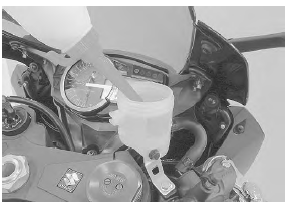
- Fill the reservoir with new brake fluid.
Bf: brake fluid (dot 4)
- Connect a clear hose to the air bleeder valve and insert the other end of the hose into a receptacle.
- Loosen the air bleeder valve and pump the brake lever until the old brake fluid flows out of the brake system.

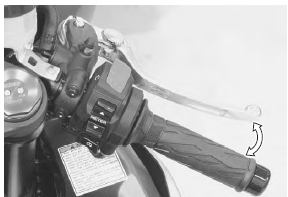
- Close the air bleeder valve and disconnect the clear hose.
Tightening torque air bleeder valve (front caliper): 7.5 N·m (0.75 Kgf-m, 5.5 Lbf-ft)
- Fill the reservoir with brake fluid to the upper mark of the reservoir.
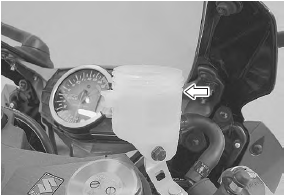
- Bleed air from the brake fluid circuit. Refer to “air bleeding from brake fluid circuit” .
- Install the diaphragm and reservoir cap.
Rear brake
- Place the motorcycle on a level surface.
- Remove the right side frame cover. Refer to “exterior parts removal and installation” in section 9d .
- Remove the rear brake fluid reservoir mounting bolt (1).
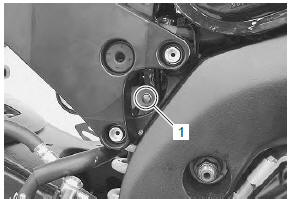
- Remove the brake fluid reservoir cap and diaphragm.
- Suck up the old brake fluid as much as possible.
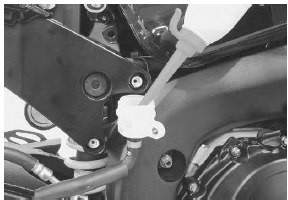
- Fill the reservoir with new brake fluid.
Bf: brake fluid (dot 4)
- Connect a clear hose to the air bleeder valve and insert the other end of the hose into a receptacle.
- Loosen the air bleeder valve and pump the brake pedal until the old brake fluid flows out of the brake system.
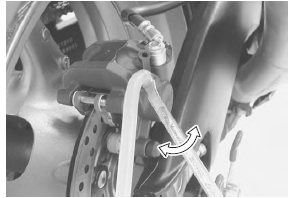
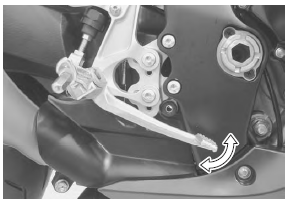
- Close the air bleeder valve and disconnect the clear hose.
Tightening torque air bleeder valve (rear caliper): 6 n·m (0.6 Kgfm, 4.5 Lbf-ft)
- Fill the reservoir with brake fluid to the upper line of the reservoir.
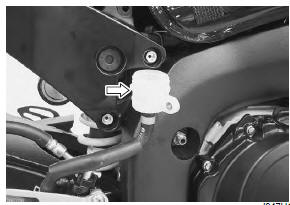
- Bleed air from the brake fluid circuit. Refer to “air bleeding from brake fluid circuit” .
- Install the diaphragm and reservoir cap.
- Install the removed parts.
 Air bleeding from brake fluid circuit
Air bleeding from brake fluid circuit
Air trapped in the brake fluid circuit acts like a cushion to
absorb a large proportion of the pressure developed by
the master cylinder and thus interferes with the full
braking performance of the ...
 Front brake hose removal and installation
Front brake hose removal and installation
Removal
Drain brake fluid. Refer to “brake fluid replacement” .
2) Remove the front brake hoses as shown in the front brake hose routing
diagram. Refer to “front brake hose routing diagram” ...
Other materials:
Electrical parts connector / coupler
Faulty fi system is often related to poor electrical
contact of connector/coupler. Before servicing
individual electronic part, check electrical contact of
the connector/coupler.
When connecting a connector, be sure to push it in
until a click is felt.
With a lock type coupler ...
Tp sensor removal and installation
Refer to “throttle body disassembly and assembly” in section 1d .
Removal
Remove the throttle body. Refer to “throttle body
removal and installation” in section 1d (page 1d-
10).
Remove the tp sensor (1) with the special tool.
Special tool
: 09930–11950 (torx wrench (5 mm))
...
Rear shock absorber adjustment
After installing the rear suspension, adjust the spring
pre-load and damping force as follows:
Spring pre-load adjustment
The set length 179.3 Mm (7.06 In) provides the
maximum spring pre-load.
The set length 189.3 Mm (7.45 In) provides the
minimum spring pre-load.
Std position
184.3 ...
